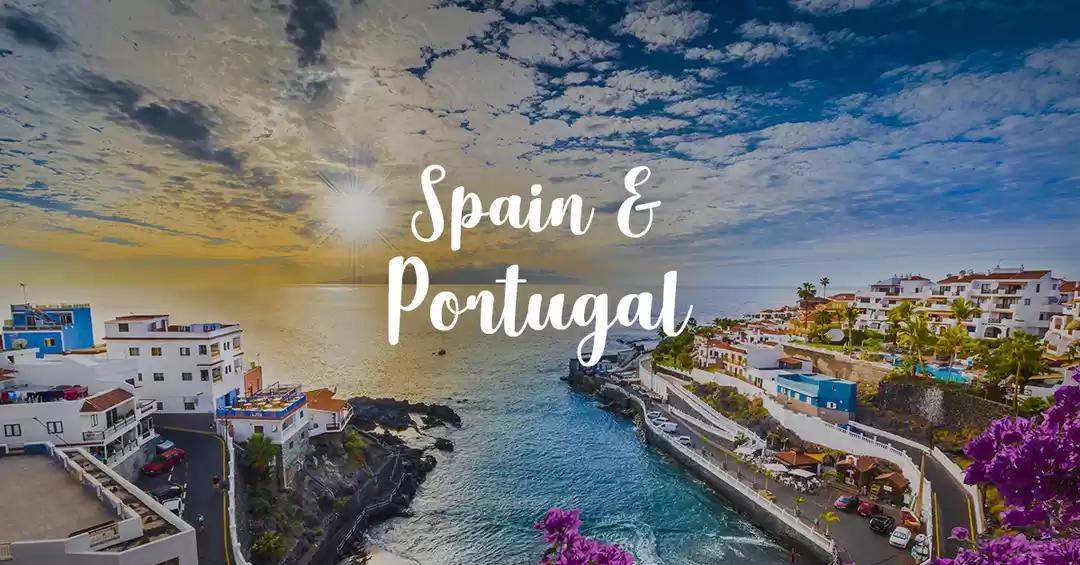Spain & Portugal
Top Five
-
12 Day Bulgaria, Serbia & Romania Tour
Discover local flavors Learn about traditional tracks Escorted tours High quality accommodation
-
12 Day Classic Romania
Discover local flavors Learn about traditional tracks Escorted tours High quality accommodation
-
12 Day Albania, Montenegro, Croatia & Slovenia
Discover local flavors Learn about traditional tracks Escorted tours High quality accommodation
-
13 Day Turkish Treasures with Cappadocia
Discover local flavors Learn about traditional tracks Escorted tours High quality accommodation
-
12 Day Central Europe with Warsaw & Krakow
Discover local flavors Learn about traditional tracks Escorted tours High quality accommodation

Spain—the name alone evokes images of feisty flamenco dancers, packed tapas bars, silver-green olive groves, and Mediterranean beaches. From Madrid to Sevilla to Barcelona to San Sebastian, the country appeals to travelers of all types: To architecture buffs, it’s the land of Calatrava, Churriguera, and Gaudí. To gastronomes, it’s the cradle of modernist cuisine (hola, Adrià brothers and Juan Mari Arzak) and ground zero for paella, saffron, Rioja wine, and acorn-fed ibérico ham. Even if you haven’t been to Spain, you’ve probably imagined it, whether through Goya’s paintings, Paco de Lucía’s guitar ballads, Almodóvar’s films, or Cervantes’s Don Quixote.
Yet while you can still find vestiges of la antigua España in Spain today, don’t be fooled by the age-old tropes: Spain is a modern, forward-thinking country with stunning hotels and agroturismos, cutting-edge galleries, bumping nightclubs, and a burgeoning restaurant scene that goes far beyond tapas and tabernas.
Madrid and Barcelona, rival cities with deep and sometimes conflicting histories, are non-negotiable stops on any tour of the Iberian Peninsula. The former boasts a bevy of world-class museums including the Prado—one of the best in the world with priceless Goyas, Velázquezes, and El Grecos amassed by royals through the ages—and the Reina Sofía, which houses Picasso’s Guernica and a stunning cocktail bar with UFO-shaped sofas and sheeny red ceilings. It’s also Spain’s cultural nerve center with a never-ending rotation of concerts, plays, sporting events, and art exhibitions, plus sundown-to-sunup nightlife to satisfy even the most debaucherous revelers.
Barcelona appeals to all the senses: There’s wine to be swirled and pristine seafood to be gobbled, passageways to be explored and paintings to be pondered. The ancient and avant-garde intermingle in the Catalan capital, where you can find Roman ruins, Moderniste apartments, and high-fashion boutiques in the span of a few blocks. Within arm’s reach are Girona, Figueres, and Cadaqués, charming beachside towns you can retreat to if Barcelona’s tourist hordes jangle your nerves.
Due southwest in Andalusia, Moorish citadels and gardens are a reminder of Spain’s rich Islamic past. Granada’s Alhambra fortress-palace complex, with its impossibly ornate arabesques, and Córdoba’s mosque-cathedral, with its millennium-old arches, are the region’s undisputed crown jewels, though it’s almost as famous for its sherry, flamenco, beaches, and palpable sense of alegría.
Every food lover should make at least one pilgrimage to the Basque Country, the autonomous region on the French border with more Michelin stars than it knows what to do with. But it’s not all tweezed-and-foamed fare here: The Basques are also famed for their pintxos, one-bite wonders similar to tapas but more elaborate, and down-home sagardotegiak (cider houses), which open their doors from January to May when the local cider is at its sour best.
West of the Basque Country lie Cantabria, Asturias, and Galicia, the misty, Celtic-influenced regions that are arguably the newest frontier in Spanish travel. Go for the Camino de Santiago or for the ski slopes atop the Picos de Europa; stay for the exceptional albariño wines and soul-satisfying cuisine (we’re looking at you, cachopo, Cabrales, and Galician-style octopus).
But Spain doesn’t stop at the Portuguese and French borders, it continues out to sea with scattered exclaves and islands. The Balearic Islands (Mallorca, Menorca, Ibiza, and Formentera) draw partiers and back-to-nature types alike with their vibrant beach scene and secret calas (inlets), while the Canary Islands, flung off the Saharan coast, are a real-life paradise with moonlike landscapes and year-round temperatures hovering in the low 80s.
The more you get to know Spain and its patchwork quilt of cultures, cuisines, and traditions, the more you realize you don’t know it at all—and that’s what makes it so thrilling to visit again and again.

Portugal Nestled between Spain and the Atlantic Ocean, it’s no surprise that Portugal has abundant seafood and beautiful beaches. Yet the landscape unfolds in astonishing variety from the coastline to the lush vineyards of the Douro River Valley to a mountainous, green interior dotted with castles. Celtic, Roman, and Islamic influences are evident in the land and its people, whose apparent reserve belies a welcoming and friendly nature. From big cities to tiny villages, a popular pursuit is to meet with friends and family and linger over strong coffee and pastries as the hours glide by.
Lisbon has so many amazing restaurants, but it’s a good idea to make reservations.
Lisbon is home to more than 50 Michelin-starred restaurants and thousands more that are both delicious and charming. Nowadays, you’ll find a mix of traditional Portuguese tascas alongside international restaurants, with an array specializing in the cuisines of former colonies. Tascas offer daily menus serving two or three courses, usually for less than 15 euros per person. You’ll often find locals chatting at counters while drinking an espresso and noshing pesticos, or small bites. It’s a great way to soak in the culture and practice Portuguese. Maybe, just maybe, you’ll want to travel back with a suitcase full of wine or olive oil.

The Algarve is deservedly popular, with millions of annual vacationers thronging here to enjoy sandy beaches, superb golf, and all the other enticements of seaside resorts. A mere 40 km (25 miles) from top to bottom, Portugal’s southernmost province is bordered by the Atlantic to the south and west, the Serra de Monchique (Monchique Mountains) and the Serra de Caldeirão (Caldeirão Mountains) to the north, and the Rio Guadiana (Guadiana River) to the east.
Its coast is cooled by sea breezes in summer, and the province as a whole is much warmer than the rest of the country in winter. The vegetation is far more luxuriant, too; originally irrigated by the Moors, the land supports a profusion of fruits, nuts, and vegetables. Proximity to the ocean, meanwhile, has allowed the fishing industry to flourish. And the region’s 300 days of sunshine per year help lure in tourists year-round.
During the past few decades, tourism has flourished, and parts of the once pristine, 240-km (149-mile) coastline are now traffic-clogged and overbuilt. Even where development is heaviest, construction generally takes the form of landscaped villas and apartment complexes, which are often made of local materials and blend well with the scenery. And there are still small, undeveloped fishing villages and secluded beaches, particularly in the west. The west is also home to extraordinary rock formations and idyllic grottoes. In the east, a series of isolated sandbar islands and sweeping beaches balances the crowded excesses of the middle.
To see the Algarve at its best, though, you may have to abandon the shore for a drive inland. Here, rural Portugal still survives in tradition-steeped hill villages, market towns, and agricultural landscapes, which, although only a few miles from the coast, seem a world away in attitude.
Madeira
Floral scents fill Madeira’s sea-washed air. Bird-of-paradise flowers grow wild, pink and purple fuchsia weave lacy patterns up pastel walls, and jacaranda trees create purple canopies over roads and avenues. The natural beauty of this island is like no other, from the cliffs that plummet seaward to mountain summits cloaked in silent fog. The magic has captivated travelers for centuries.
The colorful island of Madeira is one of Portugal’s most enchanting regions, made up of a series of dramatic volcanic peaks rising from the sea. It lies around 600 km (373 miles) off the west coast of Morocco, ensuring an alluring, balmy year-round temperature, only enhanced by the warm Atlantic currents. You’ll find everything from black-sand beaches to thundering waterfalls, manicured gardens to wild, rugged volcanos. It’s a place for hiking, but also for relaxing on the beach with a book; a place for gorging yourself on seafood, and then working it off with a swim in the inviting ocean.
Wine connoisseurs have always savored Madeira’s eponymous export, but a sip of this heady elixir provides only a taste of the island’s many delights. Other draws include the promise of clear skies, the carpets of flowers, the waterfalls that cascade down green canyons, and the great hiking along the island’s famous network of levadas. These irrigation canals have been adapted into superb walking trails, many of them passing along the dramatic coast or through an Alpine-like interior of lush woodlands and towering peaks.
Thanks to its position on shipping routes between Europe, Africa, and the Americas, Madeira grew up as an important trading post. The British have also had strong ties to the island thanks to a 16th-century royal marriage. Today they still flock to Madeira, as do other northern Europeans, especially Germans and Scandinavians. In summer, the island is especially popular with visitors from mainland Portugal, when an adventurous crowd puts Madeira’s magnificent blend of sun and seascapes to good use. The island also has some excellent museums, tranquil gardens, and a range of good restaurants.









